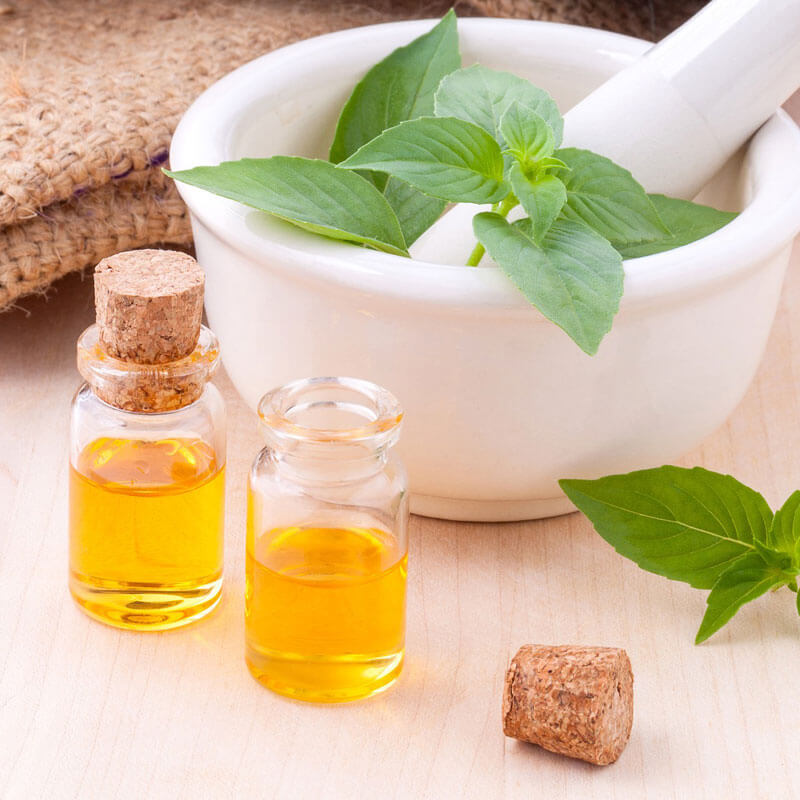Palo santo essential oil benefits have have a long history as a central component of rituals and purifying ceremonies, dating back to the time of the Incan Empire in South America. Still commonly used in traditional medicine in modern-day Peru, it is said to relax the mind and, when used in incense, for “treatment of evil wind or colds.” (1) These uses gave rise to the name “palo santo,” which literally means “holy stick.”
The aroma of palo santo essential oil is earthy, warm, and woody. It blends well with other resin oils, such as frankincense and myrrh, and with the citrus oils. It is a venerable essential oil steeped in tradition and ancient health practices supported by modern research. Try it today for its many soothing, clarifying, and cleansing benefits!
Table of Contents
Derived from the Bursera graveolens tree, palo santo essential oil is a relative to frankincense and myrrh. This aromatic tree is found in Mexico and along the Pacific South American coastline. (2)
To ensure the highest quality standard, the wood for this particular oil has to be harvested properly. The female tree is the most commonly used source – these trees are golden yellow and far denser than their male counterparts. (2)
The harvesting process is fascinating. Only dead wood is used for the essential oil and that wood must remain decaying on the forest floor for 4 to 10 years! This allows the resin of the tree to fully develop a pure and potent version of palo santo oil, which is obtained by steam distillation of the resulting wood chips. When harvested, every part of the wood is used and harvesters are careful not to harm the surrounding tree parts or fallen branches.
Is Palo Santo Endangered?
There is plenty of confusion on this topic because of the name “palo santo,” which can refer to the essential oil of two separate trees. The species Bulnesia sarmientoi is the type that is endangered, although laws have been enacted over a decade ago to try and halt deforestation of this plant. The oil from this tree has been used commercially.
For home use, palo santo essential oil should be derived from the Bursera graveolens tree, which is technically not endangered. However, according to the New York Times, the country controlling the region gets to determine whether or not a plant is endangered, as Peru did for B. graveolens back in 2005. (3)
Therefore, you may see this tree or oil listed as “endangered” in certain regions. Then in December 2019, the International Union for Conservation of Nature declared B. graveolens’s conservation status “of least concern.”
Confusing? Yep…
It basically comes down to making sure you are buying the right form of palo santo essential oil. Don’t just trust the label! Adriana Ayales, a rainforest herbalist, says, “Look for companies where they themselves have gone to the area where the trees are from, met the farmers, know their names, know the area and regularly return to the area.” (3)
As always, it’s important to know you are buying from ethical brands. They should be transparent and provide the details of their sourcing and processes. Learn how to choose the best essential oil brand.
Palo Santo Essential Oil Components
The major constituents of palo santo essential oil include the following: (source)
- Limonene (largest constituent, up to over 80% of oil)
- Alpha-Terpineol
- Menthoruan
- Carvone
- Germacrene D
Because limonene is such a potent antioxidant with the ability to fight disease, damage, bacteria, fungus, and more, palo santo essential oil is an excellent choice if you want to stay healthy and fit.
9 Benefits of Palo Santo Essential Oil
Palo santo essential oil has a long history, true, but there are also numerous applications that modern science supports. Most of these studies were done on cell cultures but the implications for the benefits of this oil are profound
1. Fights Cancer
Palo Santo contains a high concentration of limonene, which is known for its anti-inflammatory and cancer-fighting properties. In fact, a 2012 study showed that palo santo essential oil “inhibited the growth of MCF-7 breast tumor cells” and also helped kill certain cells that contribute to cancers and other diseases. (8)
While much more research needs to be done on the potential of essential oils to inhibit cancer and tumor cells, palo santo holds promise for the development of future treatments to combat this disease.
Application: Talk to your cancer support team about adding palo santo essential oil to your treatment regimen.
2. Kills Microbes
According to the Tisserand Institute, alpha-terpineol has antiviral, antibacterial, anti-biofilm, and anti-inflammatory properties. (9) As a major constituent of palo santo oil, that makes it very useful for cleaning and disinfecting purposes.
Additionally, it has shown “strong antimicrobial activity” when tested on several microorganisms, including E. coli and Candida albicans! (10)
No wonder it has been used in traditional cultures in “smudging” or ritual cleansing. While we don’t believe that burning plants can clear your air, we do think that diffusing palo santo can help clear your air from harmful microbes!
Application: Add 10 drops of palo santo per one once of your homemade cleaning solutions.
3. Useful Antioxidant
While palo santo is not the most potent antioxidant available, its prowess has been shown (11) to be powerful enough to justify its long history in traditional medicine. Antioxidants help us to fight the free radicals that cause aging and disease. Once again, limonene plays a role here since it is an important antioxidant as are the other main constituents of this oil.
Application: Diffuse 2 drops palo santo with 2 drops frankincense and 2 drops orange oil.
4. Respiratory Issues & Common Cold
Palo santo has been commonly used in traditional Peruvian culture to address cough, flu, bronchitis and cold. (12) Even today, the locals ingest palo santo essential oil to boost their immunity.
While there is no peer-reviewed data behind this use of palo santo essential oil, try it with diffusion before attempting to ingest it to ensure that you can tolerate it well.
Application: Properly dilute 2-3 drop of palo santo into a carrier oil in a vegetarian capsule. See our article on ingesting essential oils for details on how to make an essential oil gel capsule.
5. Relaxing
While there are no studies on the benefits of palo santo oil on stress and relaxation, it does have a reputation (13) for improving mental clarity and boosting mood, and is used as a tool for relaxation, reducing tension and stress. It’s commonly diffused to support meditation. No doubt its antioxidant powers reinforce these abilities!
Application: Add 3 drops each amounts of palo santo and bergamot essential oils to your diffuser for an uplifting boost to your day!
6. Insect Repellent
The resin of Bursera graveolens has been traditionally used as a mosquito repellent thanks to its aroma. (13) Today, data from a 2019 study from the University of Cartagena indicates that palo santo essential oil is effective as a safer “alternative to new natural repellents and biocides.” (14)
Palo santo has also been successfully used to reduce tick populations so this is a handy tool for your outdoor and indoor pest control solutions! (15)
Application: Add 3-5 drops of palo santo in our Homemade Bug Repellent recipe.
7. Deodorizer
The composition of palo santo essential oil makes it useful as a powerful deodorizer. (16) This may be due to the fact that it is a resin oil or because of its high limonene content. Either way, you can use this peppery aroma to remove unpleasant smells from your laundry, washing machine, or gym gear!
Application: In a 2 oz. spray bottle, add 5 drops of 2 different citrus oils plus 5 drops of palo santo oil to ½ oz. 190 proof alcohol. Fill the rest with distilled water. Use as a a spray to detox your smelly gym gear!
8. Useful For Gardening
It’s becoming more popular in this day and age for families to create their own food-bearing organic gardens. If you’re looking for good alternatives to toxic pest control for your garden, data shows that palo santo essential oil is active against certain destructive plant-eating pests such as aphids. (17)
Palo santo oil has also shown promise as a tool for sustainable agriculture with composting abilities that include stabilizing organic matter and organic vitamin C in the plants. If you are interested in learning more about growing your own plants and foods, sign up for Mama Z’s Organic Gardening course.
Application: Add 5-10 drops to your natural weed killer recipes like our Homemade Weed Killer.
9. Scented Soaps
Because of its pleasant and rich aroma, palo santo essential oil is frequently used in commercial production of soaps and perfumes. It has a “rose and violet fragrance” that makes it a popular choice. (18)
Why worry about buying perfume or soaps laden with toxic chemicals when you can use palo santo oil to create your own safe version right at home? You can also create homemade gifts for your friends and family on birthdays and holidays with this edifying scent!
Application: Add palo santo to a complementary blend of citrus oils in our Homemade Liquid Hand Soap Recipe.
Palo Santo Essential Oil & Safety
It’s wise to take caution when using these oils on the skin however, with the proper dilution, you should be safe. Tisserand and Young recommend a dermal maximum of 3.4%. We have found that going up to 5% is OK for acute pain and joint issues, as long as you’re not applying more than once per day.
Remember these common-sense tips for using palo santo essential oil:
- At present, there is no clinically safe level of dosage for children, but this doesn’t mean that you cannot give it to them. You should start off small with “culinary doses,” that is, no more than 1 drop per dish. Palo santo essential oil is safe to use in your diffuser and topical applications if you keep it to 1% or less for children.
- Don’t consume straight out of the bottle, and don’t drink with water (remember oil and water do not mix).
- Tisserand and Young write that the maximum adult oral dose is about 3 drops per day. You can consume safely by adding 1 drop of palo santo essential oil into a veggie gel capsule and fill it with olive oil. Consume with food.
- Do not stay on palo santo oil for an extended length of time. Ideally, you should rotate your oils every few weeks.
- Stop using it immediately if you experience any side effects.
- Use with caution if you take medications. Check with your healthcare provider first.
- https://tisserandinstitute.org/aromatherapy-and-plant-medicine-in-peru/
- https://sciencetrends.com/what-is-palo-santo/
- https://www.nytimes.com/2019/12/16/style/self-care/palo-santo-wood-endangered.html
- https://journals.sagepub.com/doi/10.1177/1934578X1200701130
- https://www.ncbi.nlm.nih.gov/pmc/articles/PMC6222726/
- https://www.academia.edu/6275577/A_New_and_Known_Cytotoxic_Aryltetralin-Type_Lignans_from_Stems_of_Bursera_graveolens
- https://www.ncbi.nlm.nih.gov/pubmed/23665426
- https://pubmed.ncbi.nlm.nih.gov/23285824/
- https://tisserandinstitute.org/learn-more/alpha-terpineol/
- https://www.researchgate.net/profile/Mary_Cesare_Coral/publication/320247305_Chemical_Composition_Antimicrobial_and_Antioxidant_Activities_of_the_Essential_Oil_of_Bursera_graveolens_Burseraceae_From_Peru/links/59e6df3ea6fdcc0e88249956/Chemical-Composition-Antimicrobial-and-Antioxidant-Activities-of-the-Essential-Oil-of-Bursera-graveolens-Burseraceae-From-Peru.pdf
- https://agris.fao.org/agris-search/search.do?recordID=US201900204674
- http://nopr.niscair.res.in/bitstream/123456789/10330/1/IJTK%209%284%29%20742-753.pdf
- https://www.academia.edu/2120881/Conservation_of_the_Palo_Santo_tree_Bulnesia_sarmientoi_Lorentz_ex_Griseb_in_the_South_American_Chaco_Region?email_work_card=title
- http://www.periodicos.uem.br/ojs/index.php/ActaSciBiolSci/article/view/46822
- https://www.tandfonline.com/doi/full/10.1080/10412905.2016.1278405?src=recsys&
- https://www.tandfonline.com/doi/abs/10.1080/10412905.2009.9700199?utm_medium=75238
- https://www.researchgate.net/publication/288839079_Insecticidal_effects_of_essential_oils_against_woolly_beech_aphid_Phyllaphis_fagi_Hemiptera_Aphididae_and_rice_weevil_Sitophilus_oryzae_Coleoptera_Curculionidae
- https://www.academia.edu/2120881/Conservation_of_the_Palo_Santo_tree_Bulnesia_sarmientoi_Lorentz_ex_Griseb_in_the_South_American_Chaco_Region?email_work_card=title







